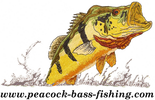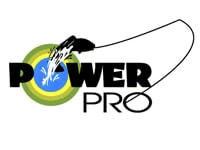|
I'm often asked which fly patterns are best for catching trophy Peacock Bass. In truth, a fly that is the right size and has lifelike movement in the water will get eaten by a few fish. Most of us, however, aren’t content to settle for ‘a few fish’ – especially when we’ve spent good money and traveled a considerable distance to pursue them; we want to show up with the fly patterns that give us the best chance at catching the fish of a lifetime. The guidelines below will help you put together a selection of flies that will greatly increase your fishing success. CHOOSE FLIES THAT ACT LIFELIKE IN THE WATER - AND WILL NOT FOUL EASILY Like many predators, Peacock Bass love flies that look and act natural in the water. Flies that breathe and have a realistic silhouette will attract the most attention. Larger profile flies are great for big Peacock Bass, but can foul easily. A fouled fly will not swim properly and will be refused by larger fish. Nothing is more frustrating than making the perfect cast to a fish only to discover that the fly’s tail is wrapped around the hook. Consider tying or selecting flies with mono guards or materials that shield the hook to prevent them from fouling. FLIES MUST TRACK STRAIGHT – ESPECIALLY AT SPEED Although Peacock Bass will ambush a fly swimming through thick cover, they love to chase flies darting rapidly away from them. They use their wide, powerful tails for explosive bursts of speed to overtake their prey. Often, a single hand retrieve is just not fast enough to get the fish’s attention. Many experienced anglers rely on a two-handed retrieve to generate the speed necessary to elicit a strike from a big peacock. USE FLIES MADE FROM DURABLE MATERIALS The Amazon River is a savage and unforgiving environment filled with a myriad of predators – many of whom have razor-sharp teeth. Piranha, Bicuda, Traira, and Payara are attracted to the same flies as Peacock Bass and will cut your 6-inch fly in half with a single bite! While natural materials like feathers and bucktail look great in the water, they just don’t hold up to toothy predators. Patterns that incorporate synthetic material like DNA, Flashabou and Steve Farrar’s Flash Blend impart plenty of action while providing increased durability. Heads finished with epoxy or UV cure adhesives will also increase the life of your fly. EYES ARE A NECESSITY
Make sure your fly patterns have large, visible eyes. Peacock Bass and other predators key in on the eyes of their prey to subdue them more quickly. As a result of this behavior, many prey species in the Amazon have developed ocelli or ‘eye spots’ on their tails to confuse predators and direct attention toward less vital parts of their anatomy. Whether you tie your own flies or pick them up at your local fly shop, following these guidelines will enable you to select the fly patterns which will offer you the best chance at making your next Peacock Bass trip a great success.
1 Comment
Rio Madeira Watershed Dry Zone #2 SW Matupiri River Water levels have gone down slower than usual in September on the Matupiri River, River Plate’s exclusive fishery in the Mahura Indian Reservation south of Manaus. Anglers have still experienced good catches of Peacock Bass averaging 35-50 Peacocks per angler boated the last three to four weeks. With the water just now approaching ideal water levels the bigger Peacocks, upwards of 19 lbs, are beginning to be caught. This fishery should produce good catches through late October. Dry Zone #1 SE Marmelos River The Marmelos River, River Plate’s exclusive Peacock Bass fishery in the Tenherin Indian Reservation south of Manaus, produced great Peacock Bass fishing from mid-July through mid-August this year with anglers averaging 40 – 45 Peacocks per day weighing upwards of 20 lbs. We did some exploratory trips as much as 70 miles above where we normally stage our Safari Camps to ascertain the multi-species fishing this area might offer. We were pleasantly surprised with the variety of fish including Peacock Bass, Jacunda, Sorbium Catfish, Piranha, Bicuda, Wolf Fish and other varieties that were caught on this trip. The headwaters offered rapids and waterfalls with crystal clear water ideal for sight casting. Next season we will be offering special trips for small groups to experience this untouched multi-species sight fishing. Rio Negro Watershed Dry Zone #3 NW Urubaxi River, Jufaris River & the main Rio Negro Water levels are dropping quickly in the upper Rio Negro Watershed from Sao Gabriel down thru Santa Isabel & Barcelos to Mora, located 200 kilometers upriver from Manaus. It looks like water conditions will make for good Peacock Bass fishing in October this year, as much as 2 or 3 weeks earlier than historic norms. With no La Nina or El Nino weather conditions apparent in the Pacific Ocean this fall and winter we are expecting excellent water levels throughout the 2017-2018 fishing season. Rio Branco Watershed Dry Zone #4 NE Xeriuni, Itapara and Omero Lakes Water levels are receding at normal historic rates in the upper Rio Branco Watershed which usually reaches ideal water levels in early January providing good Peacock Bass fishing into early March when water levels are rising to unfishable levels on the Rio Negro. If the water continues to drop normally, it is possible the tributaries to the Rio Banco could become fishable in December. FISH WITH THE BEST AWAY FROM THE REST!
There are many different operations offering Peacock Bass fishing trips in Brazil’s Amazon with the majority of them, consisting of over 50 river boats and yachts operations handling up to 30 guest per week, on the heavily fished waters of the Rio Negro operating out of Barcelos. Much like Alaska evolved into many years ago, the operators offering Fly-In trips to remote locations on private Indian lands and government have become the primo operations for trophy Peacock Bass fishing in Brazil’s Amazon. We offer upscale floating Safari Camps for small groups of 6 – 12 anglers on over 8 million acres of remote Indian lands where our anglers experience exclusive fishing rights in both single and double occupancy air-conditioned cabin Safari Camps. Check out our remote Fly-In Safari Camps and experience the great Peacock Bass fishing opportunities that were available in the 1990’s in Brazil’s Amazon. www.peacock-bass-fishing.com Fishing the Amazon Since 1992 Always wanted to fish for Trophy Peacock Bass in the Amazon? Join us on a Peacock Bass Safari and experience the very best in Peacock Bass fishing. Fly into one of our remote camps on exclusive unpressured backwaters deep in the Amazon Rainforest. Fish for Trophy Peacock Bass while enjoying our new luxury safari camp featuring air conditioned, single-occupancy cabins with queen beds and private restrooms and showers. After a hard day of fishing, unwind with a massage or sip a Brazilian Caipirinha on a sugar-white sand beach. The upscale food, wine and hospitality offered by our onsite chef and staff truly make this a trip of a lifetime. 2018 Hosted Trip with TFO Fly Fishing Celebrity Blane Chocklett Always wanted to land a Trophy Peacock Bass on a fly but aren't sure how to get started? Join Emu Outfitting and Temple Fork Outfitters on January 27 - February 3rd, 2018 and cross that item off your bucket list!
From fly casting to fly design to fishing techniques for predatory fish - learn the intricacies of fishing for trophy peacock bass from one of the fly fishing industry's most talented celebrities, Blane Chocklett. Contact us for more information. BREAKING WATER AT THE JUFARIS PRIVATE FISHERY Fly-in Floating Suites at the Matupiri river are moving towards the productive headwaters of the river. Last week´s group landed 1.336 peacock bass with 36 fish over 10lbs. with a couple over 18lbs. Anglers arriving last Saturday are enjoying great fishing. Yozuri, perversa and jigs are the best working lures this week. The Jufaris private fishery in the N.West dry-zone has been opened for the season with two floating-suites operations with two parties. Water levels are dropping at a good rate. Anglers arriving last Saturday had some rain episodes to endure but managed to land an average of over 70 peacock bass per boat, as well as bicudas, jacundas and piranhas. Dry -zone S.East is closed for the season and Dry-zone N.East is not yet open. One Floating -Suites operation has arrived at the Jurubaxis private fishery which will open shortly. Dry-zone S.West RIVERS: MATUPIRI, IGAPO ACU (see map at the top). Water levels on the Madeira River, the drainage of Matupiri and Igapo Acu, are stable (see graphic water level below). This fact, along with the weather forecast, imply that peacock bass fishing conditions will continue to be excellent which is a good fall back in case the Northern fisheries are a little late in reaching lower levels. The above diagram depicts the rainfall probability for the next three months. The light green zone in the North forecasts a probability of about 35% that the rainfall will be above the historical mean. Therefore, the dry water cycle is expected to develop almost normal in the coming months in the North of Manaus (Dry-Zones N.West and N.East). Dry-zone N.West RIVERS: XERUINI, JUFARIS, JURUBAXIS (see map at the top) Water levels on the Negro River, the drainage of rivers Jurubaxi, Jufaris and Xeruini, are descending at a good pace, and are moving towards their low historic level (see graphic water level below). This fact, together with the weather forecast for the rest of the week, indicates that peacock bass fishing conditions at the Jufaris should continue to improve for arriving anglers . See weather forecast for Moura below. The Jurubaxi is still a bit high due to recent rainfall at the headwaters. Water level chart for the Negro River where the blue line represents actual levels, the yellow line represents last year´s extremely low levels, and the red line historical extreme low water levels.
|
Categories
All
AuthorJim Kern has a long history in the Peacock Bass world. Jim has fished in Brazil 32 times since 1997 with both fly and conventional tackle. Jim developed and ran the American office for Captain Peacock from 2010 thru 2013 was the Vice President and General Manager of Amazon Tours from 1998 thru 2003. Through Emu Outfitting, his outfitting company of 30 years, he managed Alaska’s Rainbow Bay Resort from 2007-2009 & Alaska’s Angry Eagle Lodge 2013 & 2014. Jim holds a Coast Guard Captains license, has been a registered fishing guide in Alaska, Montana and Idaho and has been a fly tier for 40 years. Jim also was a 3 time American League All Star baseball pitcher in 1977, 78, and 79 & the American League Relief Pitcher of the year in 1979. Archives
October 2018
|
Let's Talk Peacocks 817.455.5374
Location |
|



















 RSS Feed
RSS Feed






